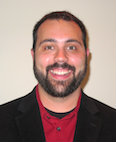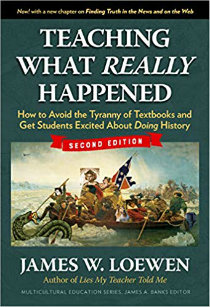Beyond the Tyranny of History Textbooks
Teaching What Really Happened: How to Avoid the Tyranny of Textbooks and Get Students Excited About Doing History, 2nd edition
By James W. Loewen
(Teachers College Press, 2018 – Learn more)

I first became familiar with James W. Loewen when a local used bookstore invited teachers from the area to come in for free books. They were cleaning house and I was happy to help.
The title Lies My Teacher Told Me: Everything Your American History Textbook Got Wrong nearly leapt right out at me.

That first year I read all I could get my hands on about how to teach history at the K-12 level. I loved history, the research, and acting like a detective piecing the evidence together. This is what I wanted to pass on to my students: curiosity about history, not some watered down, at times incorrect version of events. Students always seem to want to know the “right” answer, and I try to explain that sometimes there is no such thing.
As I fast forward to present day, I have changed how I teach my class and have read quite a bit more on teaching history. I had a previous edition of Teaching What Really Happened: How to Avoid the Tyranny of Textbooks and Get Students Excited About Doing History but was excited to see a new edition ready for review.
Loewen’s focus here is on American history, but there is still so much for teachers like me who are not teaching American history. I will focus this review on the elements that I think are useful for all K-12 history teachers.
“The Tyranny of Coverage”
Chapter 1 of the book discusses coverage and should be required reading for any person preparing to teach history. We have all been at department meetings or discussions with colleagues where “how do we cover all this?” is a question met with various lamentations on the impossibility of getting through all the material.
Loewen provides a great strategy by way of metaphor. Imagine a forest representing, for me, ancient civilizations. How can I organize all this into a meaningful school year for my students? Loewen says do not concentrate on the twigs, all the facts and dates that amount to nothing more than rote memorization. Loewen writes on page 23, “Unfortunately, the more teachers cover, the less kids remember.”
The teacher, instead, should compile a list of 30-50 topics to be covered during the year – these are the trees. Do not be hasty in making this list, sleep on it, and be sure it represents the crucial aspects of your content area and any standards you follow.
As history teachers our job is two-fold: teaching the content of the past and teaching students important skills along the way. Loewen has a great list of skills on page 33 (you’ll have to get the book) and how they can be incorporated into a course.
Lessons should be planned with both content and skills in mind. When considering content, Loewen notes not to be afraid of teaching what actually happened (rather than history’s myths). The past is complicated and can be messy.
“The critical point is this: Once teachers step forth down this slippery slope of allowing such concerns to dictate what can and cannot be learned about the past, regardless of what actually happened, they are done for. Teaching what happened is our bedrock. When challenged by student, parent, or administrator, noting that students are learning what in fact happened is a powerful first defense.” (Page 41)
We would be lying to ourselves if we didn’t at some point become frustrated with a lack of background knowledge or skills that a student possesses. That doesn’t mean you take it out on the student, but it is an internal frustration because now the lesson you have planned may be thwarted to some degree.
Loewen provides good general education advice as we deal with this. One great piece of insight from page 49 is that before a student can do well, she has to believe she can do well, and sometime before that her teacher needs to believe she can do well. Whether or not students are confident learners, they may simply not have been taught to do certain things and that ignorance should not be held against them.
Becoming Historians
When I was in graduate school, I remember seeing the word “historiography” and I was intimidated. I did not know what to make of this word. It took me some time to realize I was doing this and I understood what it meant.
Loewen encourages history teachers to scrutinize history, and how events are recorded and understood, and how this changes over time. This is an imperative step in truly understanding the past. Loewen states on page 76, “What happened in 1492 happened. But that is not history. History is what we say happened. What we say about 1492 changes as we change. Historiography is the study of why and how history changes.”
In order to provide what Loewen recommends above, a history teacher must go beyond the textbook. You will read in Loewen’s book how history is recorded in textbooks and why, in many cases, it can be wrong or oversimplified. “The most pervasive reason why textbooks supply bad history is that they simply don’t want to offend.” (Page 85)
As history teachers, like those in any other subject, we should not be teaching or discussing content we know to be untrue. Doing this is an incredible disservice to our students. There are ways to simplify and summarize without eliminating the truth. Lowen gives some excellent examples of textbooks purposefully giving wrong information. This can be through elimination or embellishment. For instance, I learned a lot about Franklin Pierce and how some textbooks changed his history to make him look better.
“Truth”
“Teachers of history might think it’s not their job to discuss current events, since they have not yet receded into history, but who else should do it? The chemistry teacher? Moreover, current events are caused by events and processes in the past, and as we have noted, the point of teaching history is to help students understand causation so they can apply the past to the present.” (Page 113)
This section is the biggest addition to the new edition of this book. Because we are in an ever-changing world in which terms like “truth” and “facts” can have alternative meanings, it is so important for us to teach students to be critical citizens.
This chapter offers great strategies on how to teach students to assess the credibility of sources. It also has a section on analyzing sources, endnotes and footnotes. The point is to make sure students are equipped to look beyond the face-value of the source. Loewen contends that we will be pleasantly surprised if we encourage our students to question sources and allow them to enter the world of rigorous historical thought.
“Teaching the truth inherently respects students. They respond to that respect by being worthy of it.” (Page 124)
Conclusion
In this review I focused on certain parts of the book that I feel can apply to teachers of all areas of history. As an ancient history teacher I found an excellent chapter that discussed archaeological and geological evidence that I will be incorporating into my class.
There is plenty for teachers of American history, including local monuments, that is very eye-opening. There is also a chapter describing why we have a Eurocentric view of history. If for no other reason than you feel your class is getting stale – or you find you need a fresh transfusion of teaching energy – this book is for you. It may seem daunting to approach students as budding historians, but it can be a powerful engagement strategy.
Keep in mind Loewen’s observation that while teachers do not always need to be experts, “The more teachers know, however, the better they can guide their charges.” (Page 129)
Michael DiClemente is a sixth grade ancient civilizations teacher in Medford, MA. Michael also advises the Middle School Model UN Club and runs the eighth grade trip to New York City. Michael is a mentor and New Teacher Liaison in his district and enjoys working with new teachers. He is a graduate of the 2018 Teacher Leadership Institute cohort.


































